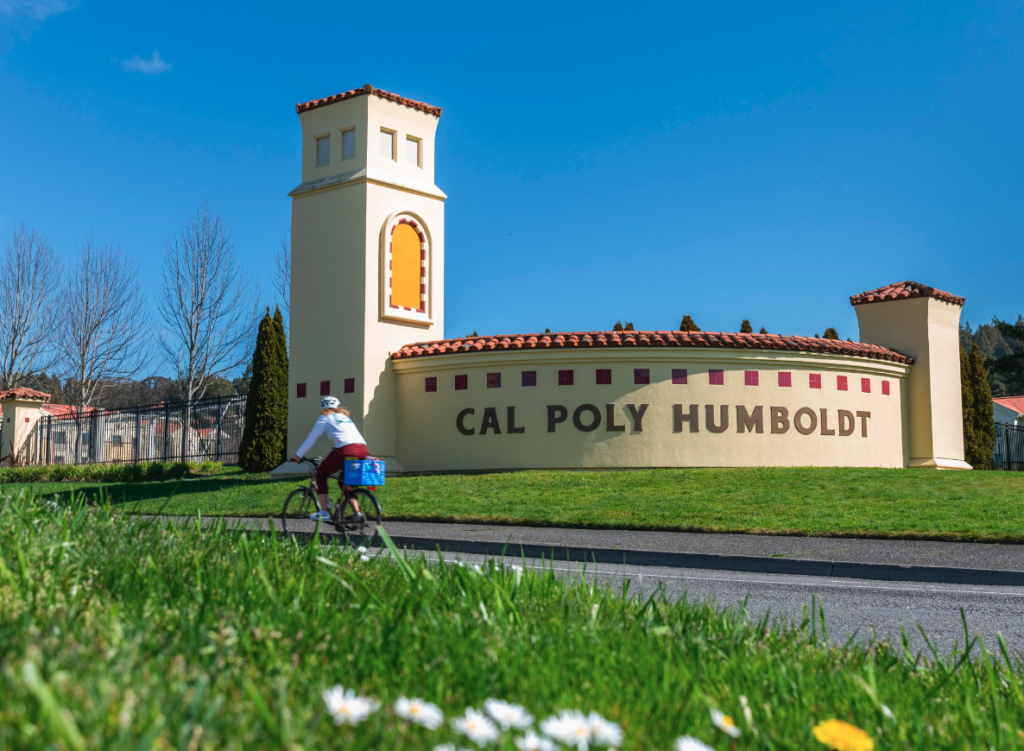A new initiative at California State Polytechnic University, Humboldt, seeks to allay students’ doubts about whether they can afford to enroll there. If there is a gap remaining after traditional financial aid awards, Humboldt says it will pick up the balance starting in the fall.
Cal Poly Humboldt’s Green & Gold Guarantee makes it the second among the 23 California State University (CSU) campuses to launch a last-dollar tuition guarantee after California State University, Fresno began one last fall. Based on previous enrollment trends, the Humboldt program could cover as many as 2,000 students a year.
The average award is expected to fill a gap of roughly $200 on average, not an enormous amount on its own but enough to provide a sense of stability to worried students, officials say. And by attracting and keeping more students, Humboldt hopes to continue its climb back from a drastic enrollment drop in the past decade.
Chrissy Holliday, Humboldt’s vice president for enrollment management and student success, said students will learn whether they are eligible for the guarantee soon after submitting financial aid applications, rather than having to wait for their entire aid package to be determined in detail. “It creates just a level of certainty that they wouldn’t have otherwise,” she said.
Cal Poly Humboldt’s guarantee program is open initially to new first-year and transfer students who are California residents or otherwise qualify for in-state tuition and meet financial criteria. It can continue for up to four years for full-time students and two for transfers. There is no separate application after filing the usual Free Application for Federal Student Aid (FAFSA) or the California Dream Act Application. The guarantee at the campus of roughly 6,000 students covers tuition and mandatory fees — such as those used to fund health services and the student center — but does not cover other expenses like food and housing.
Admissions trends suggest the program could benefit hundreds of incoming students, if not more. Cal Poly Humboldt estimates that 300 first-time students per year would have received the guarantee in 2023 and 2024 if the program had existed. The university additionally admitted an average of 1,700 applicants who would have been eligible had they chosen to enroll at Humboldt.
“When it comes to programs like this, it’s so, so helpful to students that are low-income, maybe first-generation, whose primary barrier to college access is going to be financial aid,” said Rachel Perry, who assists high school students with financial aid applications through her work with the North Coast California Student Opportunity and Access Program Consortium. “There are so many students who I see at my workshops every week that are discouraged because they feel like, ‘Even if I get some financial aid, is it going to be enough?’”
California State University, Fresno, launched a similar initiative, Tuition Advantage, in fall 2024. Phong Yang, the interim vice president for student affairs and enrollment management at Fresno State, said the program is a response to concerns from students who report in surveys that “the cost of college is always towards the top of their priorities.” Given that reality, university officials were also concerned about how the troubled rollout of the 2024-25 Free Application for Federal Student Aid might impact prospective students.
In its first year, Fresno State awarded 111 students between $70 and $3,300 through Tuition Advantage, Yang said, at a total cost of roughly $200,000. It’s hard to gauge whether the new program was a deciding factor for those students in its first year, he added, but enrollment rose 3.6% this fall from 2023.
Students weighing whether to pursue a college degree may have difficulty estimating how much their education will cost because the sticker price on many academic programs can deviate from students’ actual costs after scholarships, financial aid and loans. Living expenses can also add to students’ overall cost of attendance, adding to unpredictability.
At Cal Poly Humboldt, a full-time, first-time undergraduate living off campus with family and receiving in-state tuition could expect expenses of $12,316 a year including food, housing and other costs before aid, according to federal data for the 2022-23 school year. An in-state student living on campus faced estimated expenses of $24,856 before aid.
But if a student qualifies for financial aid, that won’t be their final price tag. At Cal Poly Humboldt, in-state undergraduates in the lowest income bracket — those with a family income of $30,000 or less — faced an average net price of $8,090 for all costs in the 2022-23 school year after average aid awards, the most recent data available. Those in the next-highest income bracket, which is capped at $48,000, had an average net price of $9,623.
The Green & Gold Guarantee could reduce tuition and fee costs further for selected students. Eligibility will be based on a measure of financial need called the student aid index, which is calculated when students apply for state or federal assistance to attend college. Manny Rodriguez, the director of policy and advocacy in California for The Institute for College Access & Success, said the program seems like it will support low- to moderate-income students, including those who receive a minimum or partial Pell Grant, a common form of federal aid. It also could support students who do not qualify for a Cal Grant because of factors like age or time out of high school, he said, even though they are Pell-eligible.
Students who take a break from school or return to Humboldt after transferring to another institution lose eligibility. The guarantee is also not open to students in graduate, credential or extended education programs, nor to students who entered Humboldt before fall 2025.
To be eligible, students must also be enrolled full time, maintain at least a 2.0 GPA and renew their financial aid application annually.
Cal Poly Humboldt, formerly Humboldt State, has in recent years transitioned to a polytechnic university, concentrating more on science, technology, engineering and mathematics programs.
The university in far Northern California anticipated that its polytechnic status would bring a wave of new students after a period of decline. That prediction has proven at least partially true: The student body grew 5% between 2021, the year before its name change became official, and fall 2024. However, overall enrollment remains more than 30% lower than a decade ago in 2015. While Cal Poly Humboldt’s beautiful location attracts students, others have felt too far away from metro areas around the state.
Cal State data shows that another challenge has been retaining students who are already enrolled. Though Cal Poly Humboldt’s first year continuation rate has risen slightly in recent school years, it still lags most of its sister campuses in the CSU system. Across the CSU system, 83% of full-time, first-time freshmen who started in fall 2023 continued to a second year, while a slimmer 76% of Cal Poly Humboldt first-year students returned to the campus for year two.
Mary Mangubat, a Cal Poly Humboldt student who participates in the Students for Quality Education internship program, which is funded by the California Faculty Association, said one of her concerns about the Green & Gold Guarantee is that it’s not open to current students. “We as continuing students don’t get a lot of support or outreach from the university,” Mangubat said, “and so people often can’t sustain themselves here on this campus and they transfer out.”
The university anticipates that the program will cost about $82,000 annually. In its first year, it will receive one-time funding from the university’s contract with food vendor Chartwells, Humboldt VP Holliday said, and will be funded by tuition revenue going forward.
This post has been updated with the legal name of California State University, Fresno.



